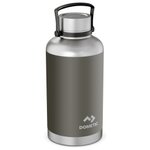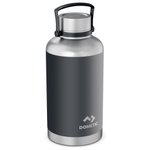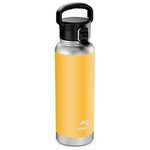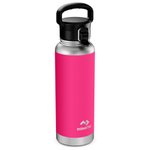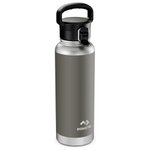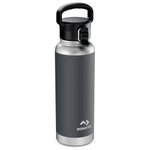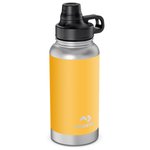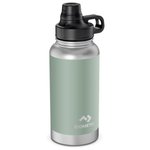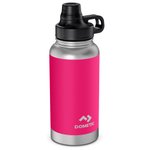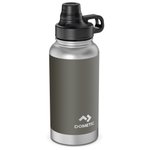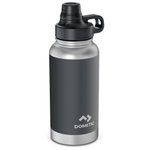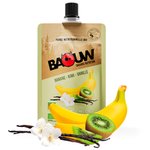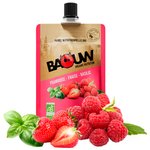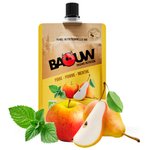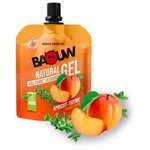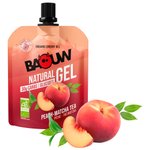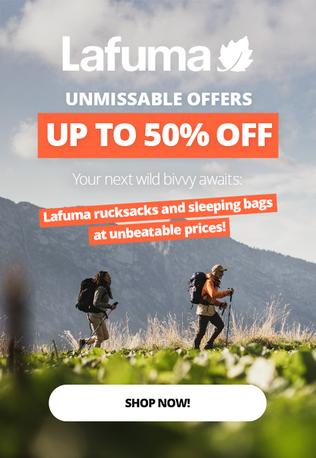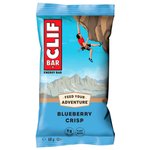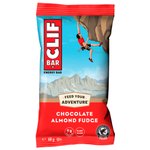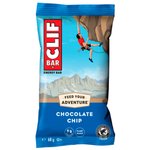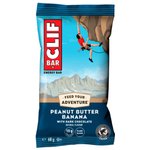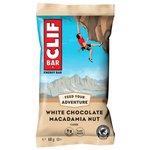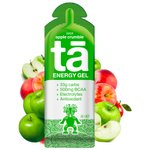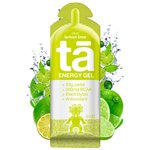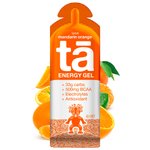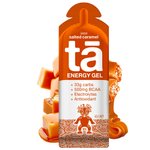Food & Hydration
What to drink for skiing, mountain biking, trail running, hiking, rock climbing or mountaineering?
For trail running, mountain biking or any outdoor activity, it is very important to drink regularly and eat to go the distance. To make sure what you carry is neither too heavy nor cumbersome, Glisshop has selected various flasks and water bladders to contain your hydration. Regarding food, compact and lightweight solutions are available too, with a complete range of sports food, encompassing gels, energy bars, etc. For camping and trekking enthusiasts, Glisshop offers various water treatment systems.
Read more Show less
 Dometic Offer
Dometic Offer
-
Recommended price
£52.11
-50%
£26.01
-

 Dometic Offer
Dometic Offer
-
Recommended price
£39.06
-55%
£17.31
-

 Dometic Offer
Dometic Offer
-
Recommended price
£52.11
-50%
£26.01
-

 Dometic Offer
Dometic Offer
-
Recommended price
£39.06
-33%
£26.01
-

 Dometic Offer
Dometic Offer
-
Recommended price
£39.06
-33%
£26.01
-

 Dometic Offer
Dometic Offer
-
Recommended price
£52.11
-50%
£26.01
-

 Dometic Offer
Dometic Offer
-
Recommended price
£39.06
-35%
£25.14
-

 Dometic Offer
Dometic Offer
-
Recommended price
£39.06
-33%
£26.01
-

 Dometic Offer
Dometic Offer
-
Recommended price
£39.06
-33%
£26.01
-

 Dometic Offer
Dometic Offer
-
Recommended price
£52.11
-33%
£34.71
-

 Dometic Offer
Dometic Offer
-
Recommended price
£34.71
-50%
£17.31
-


-
£2.83
Baouw Raspberry-Strawberry-Basil Energy Compote is a delicious source of concentrated energy, ideal for endurance efforts, made in France with 100% organic ingredients.


-
£2.83
Baouw Mango, Passion & Ginger energy compote is a light, vegan and gluten-free organic puree, ideal for a natural energy boost during exercise.


-
£3.05
Made in France, Baouw Gel Naturel Bio 85 g Abricot Thym is a vegan and organic energy gel, perfect for long-distance runners.


-
£3.05
Baouw Gel Naturel Bio 85 g Banana Vanilla energy gel is designed to support athletes' endurance with organic ingredients.


-
£3.05
Perfect for sports requiring prolonged effort, Baouw Gel Naturel Bio 85 g Fruits Rouge Hibiscus is delicious.


-
£3.05
Ideal for trail races, Baouw Gel Naturel Bio 85 g Peach Matcha Tea is made with organic ingredients.


-
£2.17
A source of protein, fiber, minerals and vitamins, the energy bar from Clif Bar Company provides the energy boost you need during your sports sessions and contains no hydrogenated oils or high-fructose sugar.
Energy bar features:
- Ingredients: oat flakes*, brown rice syrup*, roasted soy beans*, soy puffed rice, tapioca sirp*, cane syrup*, macadamia nuts, chicory root fiber, soy flour*, cane sugar*, high oleic sunflower oil*, natural flavors, sea salt, cocoa butter, soy flour, antioxidant
- *Organic
- 70% organic ingredients
- May contain: peanuts, tree nuts, milk, rye, triticale and wheat
| Nutritional values | Per 100 gPer bar (68 g)||
|---|---|---|
| Energy | 1628 kJ / 387 kcal | 1117 kJ / 266 kcal |
| Fat | 11 g | 7.5 g |
| - Of which saturated fatty acids | 2.1 g | 1.4 g |
| Carbohydrates | 54 g | 37 g |
| - Of which sugars | 25 g | 17 g |
| Fiber | 7.4 g | 5 g |
| Protein | 14 g | 9.8 g |
| Salt | 0.86 g | 0.5 g |
| Phosphorus | 241 mg | 164 mg |


-
£2.83
Baouw Bio Banane Kiwi Vanille energy purée combines the benefits of banana, rich in carbohydrates and potassium, with those of kiwi, an antioxidant rich in vitamin C.


-
Recommended price
£2.17
-19%
£1.74
TA Energy Gels Orange Mandarine are vegan, easy-to-absorb energy supplements designed for athletes, providing optimal energy through carefully selected ingredients without causing digestive discomfort.


-
Recommended price
£2.17
-19%
£1.74
TA Energy Salted Caramel Gels are vegan, easy-to-use energy boosters for athletes, providing optimal energy intake and rapid absorption without digestive discomfort.
Loading...
To nourish yourself on a multiday hike or to get a steady energy intake during a race, various options are available to you with the common goal of not overloading you and providing a maximum amount of energy.
Energy gels
Genuine energy bombs, anything unnecessary is avoided to get straight to the essential. You will find in them carbohydrates, vitamins, minerals useful to the body during an effort. Unlike energy bars which offer a progressive assimilation, gels ensure a fast and massive absorption. Under a liquid or gel form, they have the advantage to be drinkable and avoid the necessity of chewing. This allows to keep your breath and stay focused.
Gels can be flavoured, making them enjoyable to drink. It is advised to drink some water after consuming one to optimize assimilation and avoid dehydration. Prior to any race, try the gels during training to make a selection of the ones best suited to your taste and tolerance: some of them have caffeine and everyone reacts in a different way to the same amount.
To use regularly, every 45 minutes approximatively, during a prolonged effort, various types of gels allow you to make a tailored choice depending on the activity, its intensity and duration:
- Classic energy gels: Contain carbohydrates, minerals and vitamins necessary to remain fit during the activity.
- Liquid energy gels or energy chews: It is a matter of taste. Some like a liquid gel for a quicker consumption others prefer to chew on something.
- Antioxidant energy gels: To take before, during and after the race, they can contain vitamins C, E or zinc for an antioxidant effect to prevent muscle cramps. Very useful especially if the race continues the day after.
- Energy boost gels: You will often encounter the marketing claim of a “surge of energy”, and for a good reason: they pack a ton of carbohydrates immediately assimilated by the body. Ideal before an ascent or a sprint they help overcome obstacles when exhaustion is not an option.
- Caffeinated energy gels: The aim is similar to boost gels. A new peak of energy for critical moments with and added increase of alertness and focus.
- Energy gels with electrolytes: Sodium, potassium, phosphate constitute a non-exhaustive list of electrolytes. Sodium regulates the fluid balance in the body, while potassium contributes to the proper functioning of the nervous system for optimal transmission of nerve impulses for muscle contraction. This gel category is particularly useful in hot environments.
- Organic energy gels: Among the gels available, some brands use organic ingredients to create their recipes.
Energy bars
Like gels, bars help to compensate for energetic losses with a steady and controlled input. It is necessary to keep in mind that they are a not substitute for a meal and are only complementary.
Your carbohydrates level will undoubtedly diminish during the course of a physical activity, this is mostly at this moment that the consumption of an energy bar is relevant. Some even have protein in them to help the body repair muscle tissues.
Mandatory for long duration activities, they allow to keep you at your full potential while having a very small footprint. Here are the best moments to consume one:
- Before the activity: A proper meal is unavoidable and it is not necessary to add a bar for dessert, however if the activity starts a few hours after the meal, it ensures a progressive energy input during the first hour of effort.
- During the activity: This is the ideal time. The body consumes a lot of water and energy to maintain your performance and it is crucial to hydrate regularly and eat a bar every hour or half hour.
- After the activity: When the training session or the race is over and the body is exhausted, eating an energy bar helps to recover more easily and drinking minimizes muscle soreness.
Purees
The role of purees and pastes is similar to bars and gels but they feature some differences. They provide a steady carbohydrates input to prevent hypoglycaemia but offer a better energetic durability as well. Contrary to gels which have a high glycaemic index, purees have a low or moderate GI. This gives, beyond the fibres they contain, a slower sugar assimilation to reduce the glycaemic peak et therefore the reactive hypoglycaemia that follows. This allows carbohydrates to stay available longer in the blood stream and avoid bonking. More natural, puree offers the advantages of nutrients coming directly from fruits and a better digestibility.
Food supplements
During a physical activity, a proper diet is not always enough to fulfil the needs in macro and micronutrients. The body consumes fats, proteins and carbohydrates during exercise and compensating for these losses before, during and after allows to be well prepared, to keep going and to recover better afterwards. Additional inputs can be beneficial, notably in vitamins, trace elements and minerals.
Be careful to favour products based on natural ingredients. For instance, linen to help the heart and limit oxidative stress after the activity, or acerola that facilitates recovery and gives a boost to the immune system. Spirulina is an excellent food supplement, rich in nutrients, amino acids and proteins, promoting the development of muscle mass and cell regeneration. Finally, ginseng, a very rich supplement as well, boosts the immune system, improves performance, sharpens concentration and speeds up recovery.
Freeze dried meals
Freeze drying food allows to remove water without altering the nutrients. The meal is therefore much more compact and lighter, a 100g packet will give a meal of around 450g once rehydrated! This major room and weight saving is ideal for long adventures that require to be self-reliant during several days.
In addition to compactness and weight, freeze-dried meals offer a long shelf life, from 1 to 5 years or more. Indeed, the content is not exposed to the air and so cannot oxidize. The rehydration time is rather quick, it can vary from 5 to 20 minutes.
Designed to provide a healthy and varied diet, you will find a wide range of options so that, beyond being practical, the meals are diverse and to your taste. Some packets offer the possibility to eat out of avoiding the need to carry and use kitchenware and some packets can be thrown in the fire once emptied!
Hydration
In order to enjoy your favourite outdoor activity, it is crucial to have a way to hydrate yourself regularly to compensate for the enormous water loss. While the body loses on average 2 to 2.5 litres of water each day, it can be as much as 1 litre per hour during a physical activity! However, drinking too much can lead to feeling bloated, nauseous and vomiting. It is better to drink before feeling thirsty, in small amounts and regularly.
In the case of a several day hike or expedition, other questions arise. Carrying dozens of litres is not an option, you have to know the various ways to treat clear water from lakes or streams and make it drinkable to be independent in terms of water supply.
Glisshop provides you here a guide to understand how to treat water and how to preserve it.
Water treatment
If you wish to avoid carrying litres of drinking water or be self-reliant to go on a hike for several days, you can bring a filtration tool that allows the purification of clear water to make it drinkable. Useful during a river descent on canoe or a trek, you only have to remove the weight of water from your bags! We will go over all the pros and cons of the various water purification means together, but first and foremost, a few recommendations are in order:
- the water to be treated should be as clear as possible, and taken as far upstream as possible from human and polluting activities.
- Avoid stagnating water, more prone to the development of micro-organisms.
- If your only option is to collect turbid water, it is best to decant it to separate the water from floating particles, otherwise you might block the filter.
- You should collect information regarding the major risks water sources can present in the area of your expedition. If you travel in Europe or in a developing country, the risks are not the same. In a desert area evaporation can provoke a higher concentration of chemical contaminants.
- Chemical and organic water contaminations require a specific treatment or a combination of treatments, as not all methods are efficient on the same contaminants.
Chemical treatments
This method presents the huge advantage of being the lightest and having the smallest footprint. A tablet or a few drops in a litre of water is enough to purify the precious liquid in 30 minutes to 4 hours depending on the brand and the ambient temperature. This eliminates viruses, parasites and bacteria using chlorine and iodine. Other products based on silver chloride treat only certain bacteria and should be used solely for preservation.
On the other hand, the taste of treated water can remind of a swimming pool. You can add syrup or something else that is concentrated, but after the water has been treated avoiding any interreference with the chemical process. Other drawbacks, an overdosage is possible when not following the instructions and performances are greatly reduced when dealing with cloudy water.
UV rays
Fast, lightweight, efficient and space saving, this process is very handy. Water purification systems using ultraviolet lights resemble a pen that is immersed in water once activated. After a couple of minutes, having shaken the container regularly, 99.9% of pathological organisms are eliminated.
As no system is perfect, this type of treatment has some disadvantages. It is expensive, fragile and requires batteries to work, this can add weight and take more space. The water needs to be clear so that the rays are not blocked by particles and this process does not eliminate chemical pollutants. Finally, this method does not kill organisms but prevents their reproduction. For this reason, you should avoid storing the water in daylight because some organisms could reactivate.
Boiling
After boiling water for a while, pathogenic organisms will be totally eliminated. Boiling time varies depending on the atmospheric pressure. It takes about a minute to kill most pathogenic elements at sea level while at the top of mount Everest, it will take around 30 minutes because, at such an altitude, water boils at 72 degrees.
Among the drawbacks, is the waiting time for the water to heat up and then cool down, and the weight of the fuel added to your equipment to take into account. Particles and chemical pollutants are not eliminated.
Filtration
Having water go through a porous material allows to retain particles or organisms unsuitable for consumption. Filters can be membrane or ceramic, in straw or tank form and with pump or gravity operation. Complements can be added such as activated carbon or chemical treatment to improve filtration performance. They enable to get rid of particles and some chemical contaminants too if the pores are small enough. Activated carbon filters are appreciated for the fact that they make water clearer, improve the taste and can absorb numerous chemical products as well as heavy metals.
However, a few disadvantages should not be overlooked. Beyond a premium price, they also require to be cleaned regularly to avoid clogging or that biological contaminants develop. They are also weightier compared to other water treatment systems. Except for a few models, most filters do not remove viruses and let go through the bacteria that are too small. It is worth noting that pump models can be tiring to use.
Combinations
For more efficiency, it can prove very useful to combine different water treatment and filtration systems.
A filter allowing to supress particles, micro-organisms and bacteria can be used prior to a chemical or UV treatment that will take care of remaining smaller viruses and organisms.
You may also boil the water to eliminate micro-organisms, viruses and bacteria, then filter it with an activated carbon system to remove particles and chemical contaminants.
The various contaminants
The reasons to treat water are evident and identifying the various contaminants enables you to be sure of the system you require for your destination. Indeed, some countries are subjects to different contaminants than others, and most methods are only efficient on some of them.
Organic contaminants
They are subdivided into three categories. Firstly, parasitic organisms, including helminths which are parasitic worms and protozoa which are parasitic, single-celled micro-organisms. Then bacteria, another type of single-celled micro-organisms, and finally viruses which are smaller than other organic contaminants. Viruses deserve close attention particularly in developing countries because wastewater treatment systems are potentially less advanced and can let dangerous viruses go through.
Chemical contaminants
Residues of human activity, chemical contaminants can be: lead from old pipes, pesticides, chemical fertilizers or arsenic and hydrocarbons.
Water storage
Once the water is drinkable, you will need a way to store it. Be it flasks, bladders or water tanks, different formats for different uses exist.
Flasks or water bladders?
Flask: Simple, practical, a flask is a great alternative to a plastic bottle. You will find different capacities, materials and neck diameters. Some of them even feature a filter to treat water if you are not sure of its drinkability. A wide neck makes cleaning easier, but a narrow one offers a more controlled flow, more comfortable for drinking. Capacities generally range from 0.5L to 1.5L. Regarding materials, you will encounter stainless steel, plastic, aluminium and glass.
However, they have the inconvenient of requiring to stop to be taken out of the backpack. This encourages to drink more water, less often, while it is best to drink small amounts regularly.
Water bladders They are available in various capacities. A Camelbak style water bladder has several advantages, including the possibility to drink without stopping, nor unload the backpack. Another appreciated element is the fact that its weight decreases as you drink from it.
The care required by a water bladder is not more complicated that a for a flask. We recommend to always rinse the bladder, hose and bite valve, then let everything air dry. You can also get a cleaning kit with a brush for the hose, preventing the apparition of mould and bacteria. Another option is to store the water bladder in the freezer compartment of your refrigerator or in the freezer after cleaning and drying it. The cold prevents bacteria from developing.
Hydration pack: Using a hydration pack has many advantages for trail running or speed hiking (aka fast hiking). Less cumbersome than a backpack, a hydration vest has a similar design to a sleeveless jacket in which you can carry a water bladder, one or multiple flask(s) or bottle(s), cereal bars, your keys, phone, etc. In the family of hydration pack, some can be shaped like a bum bag, generally used by MTBers, as well as trail running belts, in which you can carry a soft flask.
Water containers: Ideal for treks, hiking or other outdoor activities during several days, the water container allows to store 2 to 20 litres of drinkable water in a soft, collapsible tank featuring a handle. In the case of a long expedition, punctuated by camping stops, water containers are perfect to be totally self-reliant and can be used to store the treated water taken from a river. This will provide enough to cook, wash yourself or prepare a drinking water supply for the next morning.
Maintenance: Regular maintenance of drinking water containers allows to avoid the development of bacteria and mould. If you only use your equipment occasionally it is all the more important to be very rigorous to avoid finding your gear unusable after a storage period.
You should clean the inside, the accessories, the tips, the taps, the necks and the caps. Cleaning kits provide the necessary tools to clean the most difficult parts, like the inside of tubes.



